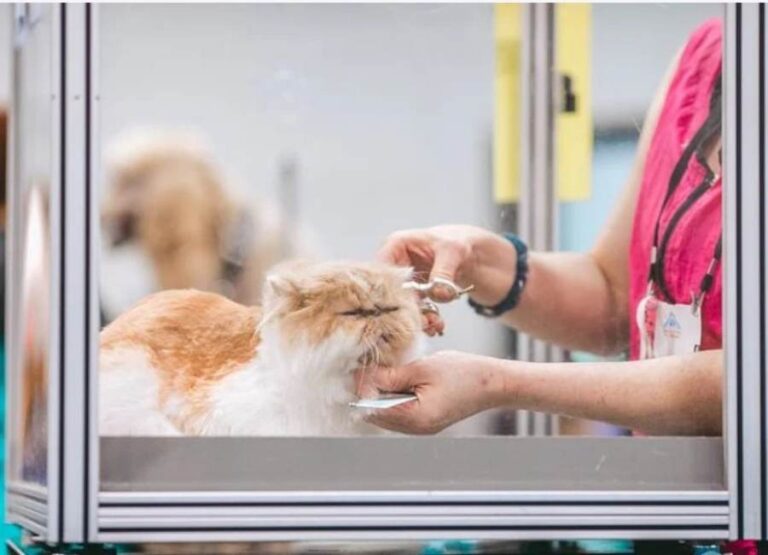6 Tips On How to Get a Scared Cat Out Of Hidings

Let’s discuss how to get a scared cat out of hidings.
This is a question most cat owners ask a lot, and in this article, we will outline all the peaceful ways to get a scared cat out of hiding.
Dealing with a scared cat can be frustrating most times as these cats keep hiding from you all day long.
There are many reasons a cat can fear its environment; abuse, trauma, being new to the environment, loud noise, or the presence of a second pet.
Hiding is one of the symptoms of a traumatized cat. However, cats can still hide when they are sick or injured.
How to Get a Scared Cat Out Of Hidings
Here are the simple ways to get a scared cat out of its hiding places which are as follows;
1. Use of treats
Using treats is the easiest way of bringing a cat out of its hiding places.
Every pet love treats and it is much easier to use treats to lure them out of hiding.
Treats are also used to appreciate a cat for doing the right thing doing training, that is why most cats are used to getting treats from their owners.
When a cat is scared the fastest thing the cat does is to hide, if you keep calling the cat when it’s scared you are making things go bad the more.
Once you find out the exact location of the cat, the best thing is to place treats in places that will attract the cat.
You can also use treats to keep a cat busy indoors by hiding treats in the house or getting automatic treat dispensers.
There are many ways to help a cat to adjust to a new environment which you should know.
2. Use of cat’s favorite toys
Every cat has a toy that makes them go crazy and finding the favorite toys for your cat can be frustrating most times.
However, getting interactive toys for your cat and teaching them how to use them can help you bring out a cat from its hiding place.
Let’s assume you get a moving mouse for your cat, and something scared your cat that it is hiding.
It will be easier to bring the cat out of its hiding place with the moving mouse.
Get lots of interesting and interactive toys for your cat and keep introducing your cat to each toy and see which one your cat prefers.
Learn more about making a cat sleep with you.
3. Use high-flavored food
No matter how you see it, a cat is always a cat and can be reached by the use of highly flavored food.
A good example is microwaving fresh tuna and placing it in a feeding place.
Once you notice the exact location of your cat, place the irresistible microwaved tuna close to the entrance.
Once your cat hears the smell of microwaved tuna, your cat can only resist the smell for some seconds before coming out.
Do not rush your cat when it comes out, drop more tuna outside and create a cat-enabling environment around.
Give your cat a small quantity of microwaved tuna at a time just to attract your cat, and keep dropping the tuna until your cat completely comes out.
There is much high-flavored food that can bring out your cat from its hiding places. The idea here is just to use the food to lure your cat.
4. Removing the scary object
A cat can not be scared for nothing, something is really causing the cat to be scared.
So helping the scared cat come out of its hiding place is just to remove or take away every object that causes the cat to be scared.
It could be the presence of a dog or other pets that scares the cat, and once a cat is scared, hiding is the next option.
So you have to be smart and look out for things that get the cat scared and remove them.
If your cat feels threatened he will try to hide so always find out why your cat is hiding.
If it’s an object, noise, or event, keep it away from your cat.
Learn more about why your cat is hiding and not eating.
5. Switching to a better cat environment
When a cat goes to an unfamiliar environment, it’s right for the cat to be scared, but once you notice your cat is scared you should consider switching to a better cat environment.
Cats love a quiet environment a lot, so when a cat is scared, be sure to check if the cat is scared because of the loud environment.
Once you notice the environment is too loud for your cat, consider switching to a quiet environment by shutting down every noise that affects the cat.
You can lock your cat down in the basement where there is less noise, and the cat will get over the noisy condition faster.
Read more: Where Do Feral Cats Sleep: 9 Places You Should Know & More.
6. Sit close to your cat’s hiding spot and talk to it
Scared cats will always want to hide, by hiding if you cannot talk to the cat, it might consider running away.
Your presence will play an important role in helping a cat to get through when scared.
Talk to your cat and show concern about your cat’s scary condition.
If you fail to stay close or pay close attention to a scared cat, the cat condition can not get better therefore, always check on your cat.
Learn more about adopted stray cat behaviors.
How to know a cat is scared
Here are the best ways to find out if your cat is scared.
- Excessive Vocalization
- Running Away
- Hiding
- Losing control of the bladder
- Freezing at a point
- Increased aggression
- Refusing to use the litter box.
- Refusing food or toys
How long will a scared cat hide outside
A scared cat can hide outside for one week or more, as long as what scares the cat is still within the house.
Cats love calm environments, and when their current environment is not calm, they can look for where to hide.
There are a few things that can make a cat scared and would force the cat to hide outside its home;
- Loud noises
- New family member
- Abuse
- Hunger
Learn more about things that scare cats.
How to get a sick cat out of hiding
Cats are wonderful at concealing sickness, but most times you can find out your cat is sick when it hides unnecessarily.
Here are the ways to get a sick cat out of hiding;
- Call the cat out by its name
- Use treats to lure the cat out
- Use a thick blanket to prevent the cat from biting your hands, and gradually pull the cat out.
- Leave the door to its room open and keep food in an open pathway.
Learn more about the signs of a sick cat and how to comfort your sick cat.
There are many ways to help a frightened cat.
But the most important thing is to find out what causes the cat to be scared.
Whatever causes a cat to be so scared that it goes into hiding can also force the cat to run away.
So keep a close watch on your cat and keep scary things away.
Find out more about How to train a cat to stay indoors.
Common Reasons Why Cats Go Into Hiding
Here are some common reasons why cats go into hiding:
- Fear: Cats are known to go into hiding when they feel scared or threatened. It could be due to loud noises from fireworks, construction, or thunderstorms. Domestic cats will often run and hide under a bed or behind furniture when they feel threatened.
- Illness: When cats are not feeling well, they tend to hide. This could be due to pain, discomfort, or being overwhelmed by their sickness.
- Stress: Cats are susceptible to the effects of stress just like humans. They may retreat to a safe and secure space when they feel stressed out.
- New environment: Cats may need time to adjust when they move to a new home. They may feel uncertain about their new surroundings, which could trigger their hiding behavior.
- Company: Cats are naturally wary of strangers or new people, and may run into hiding when they have visitors.
- Pregnancy: Female cats instinctually find a safe and warm place to hide when they are ready to give birth.
- Aging: Senior cats may spend more time hiding as they get older. This may be due to the lack of energy or the need for a quiet and peaceful resting environment.
- Playtime: Sometimes cats hide as part of their normal play behavior. They may ambush from their hiding spots and pounce on their prey.
- Hunger: Cats in the wild hide in order to hunt prey. Domestic cats may sometimes hide when they are hungry, especially if their feeding schedule has been disrupted.
Frequently Asked Questions
Why do cats hide and how do I know if my cat is scared or just hiding for fun?
Cats are natural-born predators and hiding is their instinctive behavior, especially when they are afraid or anxious.
If you notice your cat hiding more often than usual or avoiding interaction, it could be a sign that they are scared or feeling stressed.
What should I do if I suspect that my cat is scared but hiding?
The first step is to create a safe and comfortable environment for your cat by providing a cozy bed, toys, food, and water.
Try to approach your cat calmly and speak in a soothing tone to reassure them that they are safe.
If your cat is still hiding, try to lure them out with treats or toys.
What shouldn’t I do when trying to get a scared cat out of hiding?
Avoid loud noises or sudden movements as they can startle your cat and cause them to retreat further into hiding.
It’s also important not to force your cat out of hiding or punish them for hiding, as this can make them even more scared and stressed.
Is there anything I can do to prevent my cat from hiding in the first place?
Providing a safe and comfortable environment for your cat is key.
Make sure they have plenty of hiding spots, but also areas where they can interact and play with you.
Regular playtime and mental stimulation can also help prevent boredom and anxiety.
What if my cat refuses to come out of hiding no matter what I do?
If your cat is not responding to your efforts and appears to be scared or stressed, it may be time to consult with a veterinarian or a professional cat behaviorist.
They can assess your cat’s behavior and provide guidance on how to help them feel comfortable and secure.
Can I train my cat not to hide or be scared?
While you can’t eliminate your cat’s natural instinct to hide, you can help them feel more secure and less scared.
Consistency, patience, and positive reinforcement are key when it comes to training your cat.
Providing them with a safe and comfortable environment, regular playtime, and social interaction can also go a long way in reducing their stress and anxiety.
Conclusion
In conclusion, getting a scared cat out of hiding can be a challenging task, but with patience, persistence, and a few tricks up your sleeve, you can help your furry friend feel safe and secure once again.
Remember to approach the situation calmly, use enticing treats and toys, and create a comfortable and inviting environment for your cat to explore.
With these tips in mind, you’ll be able to coax your cat out of hiding and back into your loving arms in no time!




![Why Does My Cat Smell So Bad [12 Potential Reasons] Why Does My Cat Smell So Bad](https://petcreeks.com/wp-content/uploads/2023/10/cat-3054260_640.jpg)

